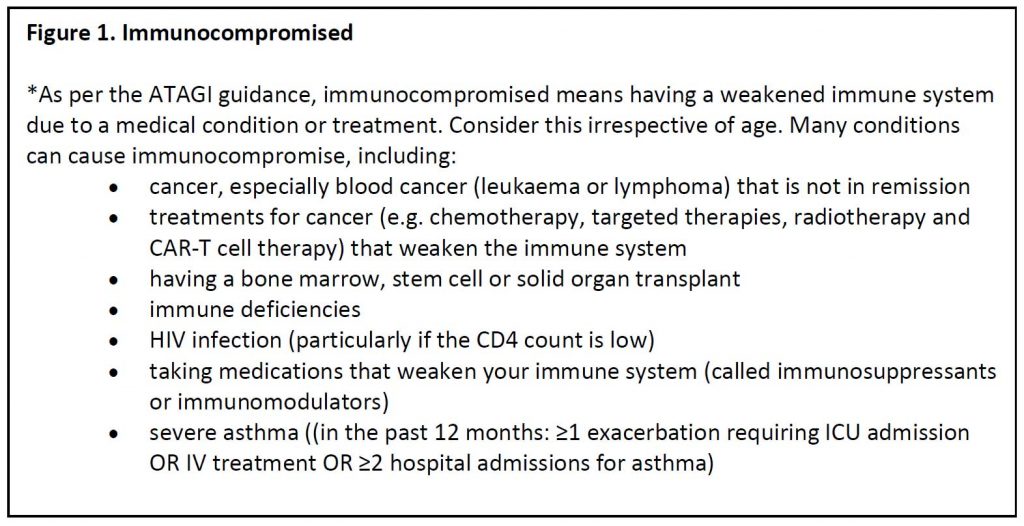12the February 2022, Dr Chee L Khoo

There is quite a bit of things to know about these medications for patients who are infected with covid-19 who are at high risk of severe disease. Whether we like it or not, we have to know them. The number of patients who qualify may not be large but we need to know who needs them and how to prescribe them as they need to be started early in the disease and not when they become sick (severe). It’s one of those “see your GP” messages your patients will receive when they test positive for Covid-19. You don’t want to start looking for the information then. Here is the long and short of it.
Step 1 – does patient qualify for antiviral?
There are three criteria they must satisfied:
- Diagnosis confirmed by PCR or RAT
- Onset of symptoms <5 days and no oxygen is required
- Have reduced immunity:
3a. IMMUNOCOMPROMISED* (see Figure 1)
OR
3b. UNVACCINATED or PARTIALLY VACCINATED AND
- Pregnant women any age in their second or third trimester OR
- Non-pregnant adults who are aged ≥ 65 years (or ≥35 years if Aboriginal and/or Torres Strait Islander) AND one of the following risk factors:
- obesity (BMI ≥ 30 kg/m2)
- severe cardiovascular disease (including hypertension)
- severe chronic lung disease; including severe asthma (requiring a course of oral steroids in the previous 12 months), COPD and interstitial lung disease
- type 1 or 2 diabetes mellitus
- severe chronic kidney disease, including those that are on dialysis
- severe chronic liver disease OR
- Adolescents aged 12-17 years old and weigh at least 40kg and have:
- paediatric complex chronic condition (PCCC): congenital and genetic, cardiovascular, gastrointestinal, malignancies, metabolic and neuromuscular
- diabetes (requiring medication) and pre-gestational diabetes (requiring medication) in pregnant women
- obesity (BMI ≥ 95th centile for age)
- chronic kidney disease (GFR <15 mL/min/1.73m2)
- heart failure or congenital Heart Disease with persisting cyanosis or pulmonary hypertension
- chronic obstructive lung disease (e.g. chronic lung disease requiring oxygen, cystic fibrosis with reduced lung function)

Step 2 – Choose anti-viral
If they qualify based on the above three criteria, then we can choose from two oral or one iv anti-virals depending on the patient’s access to hospital based clinic for infusion. Patients who are pregnant and adolescent can only have the iv Sotrovimab. See Figure 2.

Oral antivirals
For oral therapy, you can prescribe either Molnupiravir (Lagevrio) or Nirmaltrevir/Ritonavir (Pavlovid). Neither are recommended for pregnant women or adolescent and contraception for both partners during drug therapy and three months after.
Molnupiravir is a ribonucleoside analog (antiviral) that inhibits the replication of SARS-CoV-2, the causative virus of COVID-19. Clinical trials for molnupiravir were conducted when the Delta variant of SARS-CoV-2 was in circulation. Clinical efficacy against the Omicron variant is not yet clear. See full Drug Guidelines here.
Nirmaltrevir/Ritonavir is not suitable for severe renal (eGFR <30 ml/min, dose adjustment between 30-60 ml/min) and liver disease. There are also lots of potentially serious drug-drug interaction. See Drug Guideline here.
IV antiviral
Sotrovimab is the only anti-viral suitable for pregnant women and for adolsecents. We have sotrovimab clinics at Bankstown, Liverpool and Campbelltown Hospitals and contact details are here.
Once you have chosen the antiviral agent, provide a consent form for the patient to sign. You should also provide a patient fact sheet to the patient or the family.
Patient Fact sheet for Molnupiravir
Patient fact sheet for Paxlovid
Step 3 – Complete prescription/declaration form and fax
When your patient test positive either in the RAT or PCR, they are encouraged to register with Service NSW. They are further encouraged to do the quick survey to ascertain whether they are at risk of getting severe disease. If they are, they will be asked to contact you, their GP for prescription of the antivirals.
The combine “prescription/declaration” form is designed to guide you through the qualifying criteria and the choice of agents. It also prompt you to discuss consent with the patient (and their family) and suggest that you enter that in the clinical notes. You will be able to download the form from SWS Healthpathways site from here. I have seen the form but I am not allowed to post the form on this website to prevent unauthorised access to the prescription/declaration form.
Fax the completed and signed form to your local hospital pharmacy. The email and fax numbers of your local hospital pharmacy is on the last page of the prescription/declaration form.
See it’s that simple.
